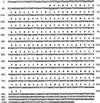Expansins are conserved in conifers and expressed in hypocotyls in response to exogenous auxin
- PMID: 10398718
- PMCID: PMC59321
- DOI: 10.1104/pp.120.3.827
Expansins are conserved in conifers and expressed in hypocotyls in response to exogenous auxin
Abstract
Differential display reverse transcription-polymerase chain reaction was used to detect the induction of gene expression during adventitious root formation in loblolly pine (Pinus taeda) after treatment with the exogenous auxin indole-3-butyric acid. A BLAST search of the GenBank database using one of the clones obtained revealed very strong similarity to the alpha-expansin gene family in angiosperms. A near-full-length loblolly pine alpha-expansin sequence was obtained using 5'- and 3'-rapid amplification of cDNA end cloning, and the deduced amino acid sequence was highly conserved relative to those of angiosperm expansins. Northern analysis indicates that alpha-expansin mRNA expression increases 50- to 100-fold in the base of hypocotyl stem cuttings from loblolly pine seedlings in response to indole-3-butyric acid, with peak expression occurring 24 to 48 h after induction.
Figures



References
-
- Altschul SF, Gish W, Miller W, Myers EW, Lipman DJ. Basic local alignment search tool. J Mol Biol. 1990;215:403–410. - PubMed
-
- Cosgrove DJ. Plant cell enlargement and the action of expansins. Bioessays. 1996;8:533–540. - PubMed
-
- Cosgrove DJ. Assembly and enlargement of the primary cell wall in plants. Annu Rev Cell Dev Biol. 1997;3:171–201. - PubMed
Publication types
MeSH terms
Substances
Associated data
- Actions
- Actions
- Actions
- Actions
- Actions
LinkOut - more resources
Full Text Sources
Research Materials

